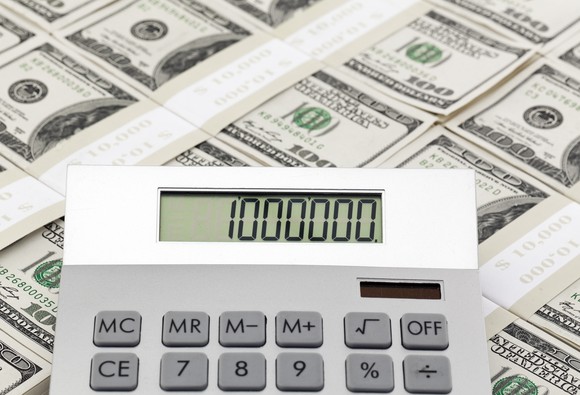Index funds give investors access to near-market returns with no stock picking or market timing required. But are market-level returns enough to grow your retirement account to seven figures? That's the million-dollar question.
The easy answer is -- yes -- you can retire a millionaire with index funds. Though as you might expect, it depends on how much you invest in those index funds and for how long. Specifically, if you have more than 30 years between now and retirement, an ongoing monthly contribution of $400 to $900 in index funds should get you to millionaire status.
As the table below demonstrates, when your timeline is shorter than 30 years, reaching the seven-figure goal is harder, because the monthly contributions required get pretty steep.
|
Years Until Retirement |
Monthly Contribution to Reach $1 Million |
|---|---|
|
10 |
$6,030 |
|
15 |
$3,315 |
|
20 |
$2,030 |
|
25 |
$1,320 |
|
30 |
$880 |
|
35 |
$600 |
|
40 |
$420 |
Data source: Author calculations.
These figures assume average annual growth of 7%, which aligns with the stock market's long-term performance after inflation.
Here's the funny thing about the stock market. Market downturns make the headlines, but strong markets can be more impactful to your balance over time. The last 10 years is a great example. Between 2010 and 2020, the S&P 500 index produced an annualized return of 12% after inflation. That's much higher than the 7% long-term average.
While it's smart to plan for the more conservative 7% growth rate, know that your actual experience could be quite different. The market can underperform in shorter timeframes, but it can also outdo that long-term average. And when the market does better than what you'd planned, a goal that seems impossible today may turn out to be realistic. The only way to know is to start investing what you can and then reassess your progress every few years.

Image source: Getty Images.
Choosing index funds that'll get you there
There are many financial market indexes, but the one that's most easily investable is the S&P 500, a basket of the largest publicly-held companies in the U.S., including Apple, Microsoft, Amazon, Facebook, Alphabet, and Johnson & Johnson. Combined, the value of the S&P 500 companies represents 80% of the total value in the U.S. stock market. That's a big reason why the investment community uses the S&P 500 as a benchmark for the market as a whole.
Index funds mimic the performance of the S&P 500 by either holding all 500 index companies or a representative sample. The difference between those two approaches may not be terribly material to you as an investor. What is material is the result -- that is, how closely the fund's performance aligns with the index. The difference in performance between an index fund and its index is called tracking error. The lower the tracking error, the better.
Generally, a fund's operating expenses are the largest contributor to tracking error. For example, iShares Core S&P 500 ETF (IVV 1.09%) has very low expenses at 0.03% of your investment. Over the 10 years ended Dec. 31, 2020, IVV grew 13.83% on average. In the same timeframe, the S&P 500 grew 13.88%. That's a difference of 0.05%, which is pretty efficient.
Alternatively, you could invest in iShares S&P 500 Index Fund (BSPAX 1.00%).This is a mutual fund with an expense ratio of 0.35%. This fund's 10-year average growth is lower than IVV's by 38 basis points at 13.45%.
As you can see, it pays to compare index funds based on their expenses and historic performance relative to the index. Even fractions of percentages add up to real dollars over time.
Start now, reassess later
You can retire a millionaire on index funds, if you start early and invest regularly. Even if you're behind schedule, invest what you can afford today and reassess your progress after a few years. That way, if the market does you a favor and outperforms for a time, you'll reap the benefits and get closer to your million-dollar goal.
